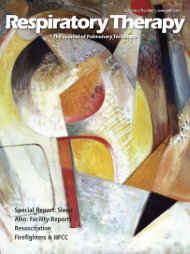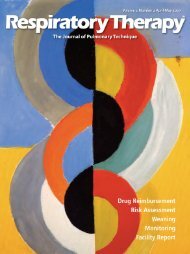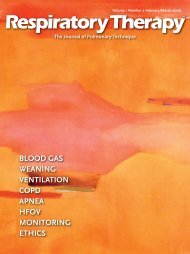RT 02-03 JJ07 main web - Respiratory Therapy Website
RT 02-03 JJ07 main web - Respiratory Therapy Website
RT 02-03 JJ07 main web - Respiratory Therapy Website
Create successful ePaper yourself
Turn your PDF publications into a flip-book with our unique Google optimized e-Paper software.
Articles<br />
Challenges in Critical Care:<br />
The Brooklyn Hospital Center –<br />
Capnography, A Valuable Asset<br />
Founded in 1845, The Brooklyn Hospital Center (TBHC) has<br />
become a major healthcare resource for the residents of New<br />
York City’s largest borough. Equipped with the most sophisticated<br />
diagnostic and therapeutic modalities and state-of-the-art<br />
technology, TBHC is committed to excellence in patient care.<br />
To provide the best possible respiratory care to the 200,000<br />
patients it sees annually, the hospital has a fleet of MAQUET<br />
SERVO-i ventilators equipped with advanced functionality.<br />
Among the SERVO-i’s advanced features is an optional<br />
analyzer/monitor capable of measuring expiratory carbon<br />
dioxide (CO 2) concentrations during a respiratory cycle. Results<br />
of the measurement of CO 2, referred to as capnography, are<br />
graphically displayed on the ventilator screen in a breath-bybreath<br />
waveform, or capnogram.<br />
The multi-disciplinary respiratory care team at TBHC finds that<br />
capnography is very useful as a noninvasive monitor for<br />
assessing ventilated patients.<br />
While not a replacement or substitute for arterial blood gas<br />
sampling, the CO 2 analyzer allows for assessment of a<br />
placement of an endotracheal tube in the patient’s airway,<br />
ventilator settings and similar measurements, says M.<br />
Shahjahan, R<strong>RT</strong>-NPS, RPFT, Director of <strong>Respiratory</strong> Care<br />
Services. The trend information that the analyzer provides is<br />
valuable for reviewing the effectiveness of changes in the<br />
ventilator, he says.<br />
Waveform<br />
Waveform can provide assurances and suggest when changes<br />
may be needed. To use the CO 2 analyzer, an airway adaptor is<br />
placed at the Y-piece and a sensor snapped onto the airway<br />
adapter. The CO 2 analyzer module receives signals from the<br />
infrared sensor that reflect the variations of CO 2 in the<br />
expiratory gas. The monitoring, which is continuous, is shown<br />
both in a waveform and numeric value indicating the CO 2<br />
The views, opinions, and assertions stated by The Brooklyn Hospital Center<br />
staff members in this article are strictly those of the clinicals and<br />
administrators, and do not necessarily reflect the views of MAQUET. This<br />
article was provided by Maquet, Inc, Bridgewater, NJ, maquet.com/us.<br />
Members of<br />
<strong>Respiratory</strong> Care<br />
Services<br />
discussing the<br />
role of CO 2<br />
monitoring in<br />
patient care.<br />
concentration of the end tidal carbon dioxide concentration<br />
(ETCO 2) and the rate of elimination of CO 2 or VCO 2.<br />
Shahjahan explains that the shape of the waveform can indicate<br />
changes in the patient’s condition. “If you look at the waveform,<br />
and if it is square, you know you are dealing with very good<br />
lungs and a relatively normal lung function. As the patient’s lung<br />
fuction is improving, a squarer waveform is a very good sign.”<br />
However, he says, if the waveform is non-constant (not square),<br />
it can suggest that adjustments need to be made in settings. “If<br />
the waveform is slowly rising, it tells you that you don’t have<br />
uniform ventilation, and you may have to do something to aid in<br />
the resoution of the disease or clinical condition that is<br />
emerging,” Shahjahan says.<br />
CO 2 monitoring also gives the staff assurance that the ET tube is<br />
in the trachea, says Rana Ali, MD, Medical Director of the<br />
<strong>Respiratory</strong> Care Unit. Farhad Arjomond, MD, Medical Director,<br />
<strong>Respiratory</strong> Care Services, adds that the monitoring device is<br />
also very useful during recruitment maneuvers where high<br />
transpulmonary pressures may cause a fall in preload and<br />
cardiac output. “A sudden drop in ETCO 2 may mean low<br />
pulmonary perfusion; therefore, higher PaCO 2 to ETCO 2<br />
difference.”<br />
Benefits in the OR and Pediatric ICU<br />
The CO 2 analyzer has benefits in the OR and in the pediatric<br />
ICU. Shahjahan says the CO 2 monitoring device is of most value<br />
in the operating theater to confirm the placement and continued<br />
secure presence of the endotracheal tube in the trachea. He says<br />
<strong>Respiratory</strong> <strong>Therapy</strong> Vol. 2 No. 3 � June-July 2007 25











